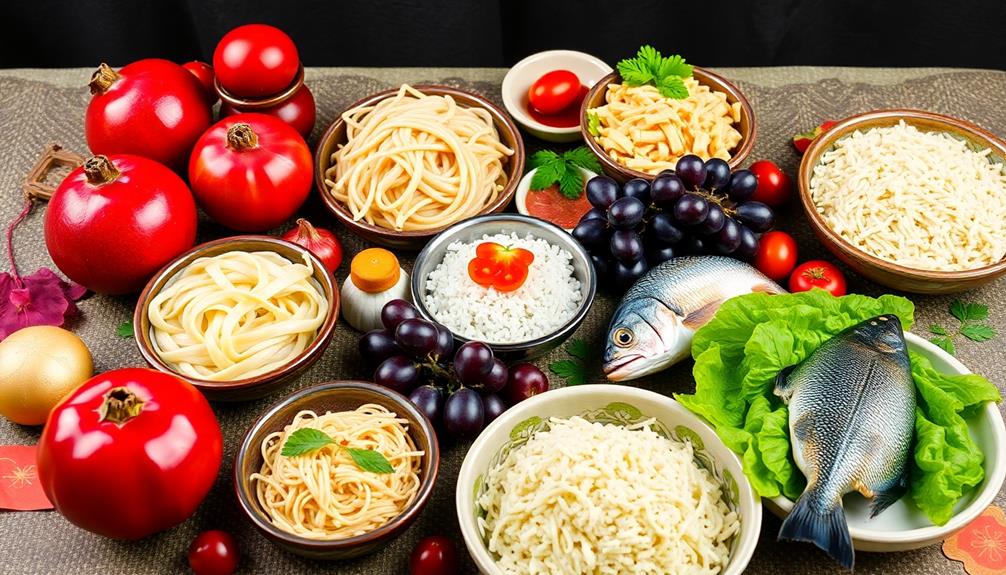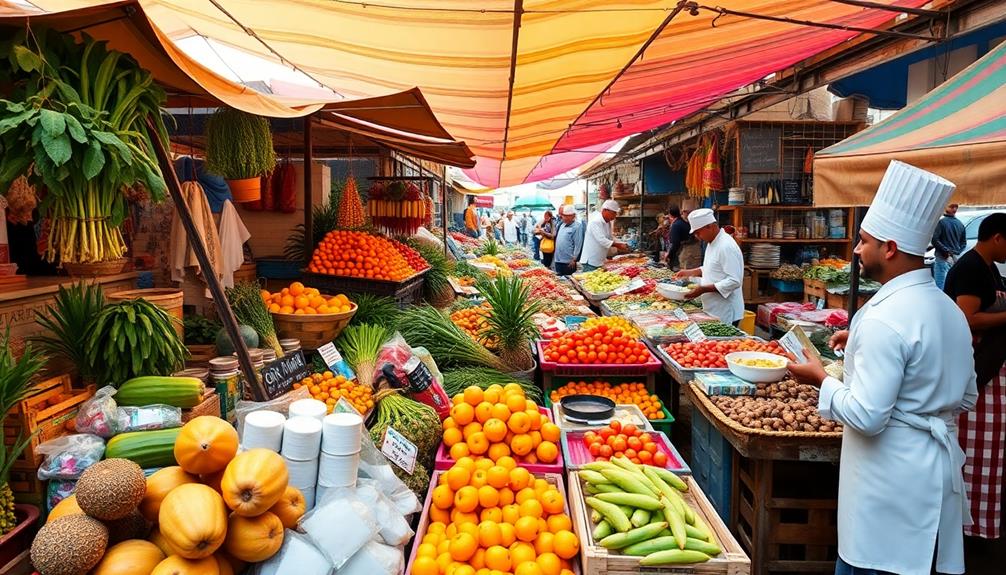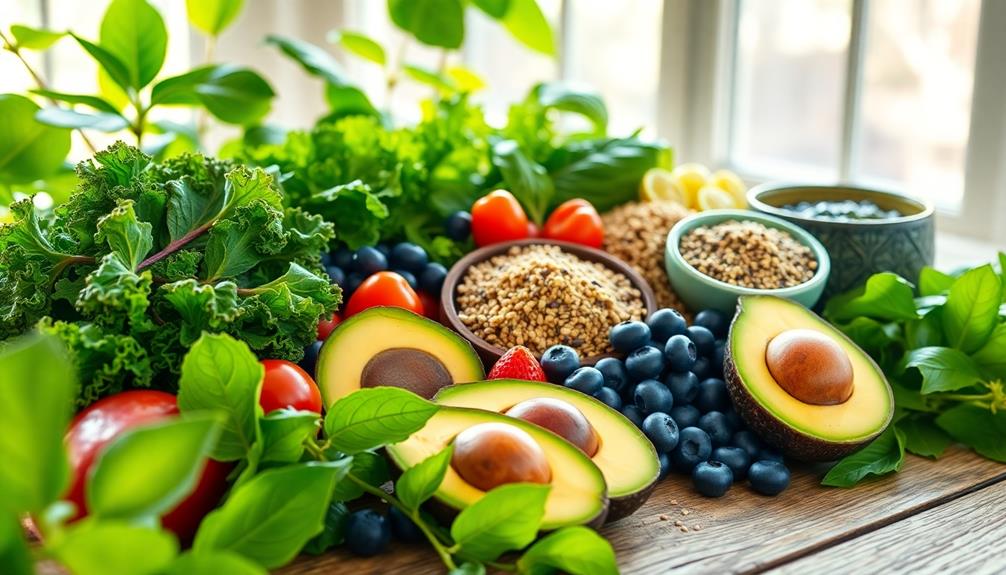Certain foods are seen as lucky in various cultures because they embody values like prosperity, health, and abundance. For instance, black-eyed peas in the Southern U.S. symbolize financial success during New Year celebrations. In Spain, eating twelve grapes at midnight brings luck for each month. Round fruits like oranges represent wealth and completion, while long noodles in Asian cultures signify longevity when eaten unbroken. These lucky foods often tie families together, enriching traditions and celebrations. Want to explore more about lucky foods and their meanings across different cultures? You'll uncover fascinating insights as you continue your journey.
Key Takeaways
- Foods are deemed lucky due to their shapes and appearances, symbolizing wealth, prosperity, and abundance, like coins or round fruits.
- Cultural traditions dictate the consumption of specific foods during celebrations, linking them to rituals and societal beliefs about luck.
- Long noodles represent longevity and resilience, consumed unbroken to signify a long and prosperous life in various cultures.
- Sharing lucky foods during family gatherings reinforces social bonds and cultural heritage, fostering togetherness and community spirit.
- Historical significance and local beliefs contribute to the association of certain foods with luck, varying widely across different cultures and celebrations.
Cultural Significance of Lucky Foods

Across many cultures, specific foods are believed to bring good luck and symbolize prosperity, health, and longevity. For instance, dishes like Mushroom Masala demonstrate how certain ingredients can carry deep symbolic meanings tied to cultural traditions, enhancing the experience of communal meals.
You'll find that lucky foods often carry deep symbolic meanings tied to cultural traditions. For instance, black-eyed peas are a popular choice during New Year celebrations, representing prosperity due to their coin-like appearance. Similarly, round foods like grapes and oranges signify completeness and wealth, with customs surrounding their consumption reflecting beliefs about good fortune.
In Asian cultures, long noodles embody longevity and resilience. Eating unbroken noodles during festivities signifies the desire for a long and prosperous life.
This emphasis on lucky foods extends beyond individual consumption; the communal aspect of sharing these dishes during family gatherings strengthens social bonds and reinforces cultural heritage.
New Year's Food Traditions

When ringing in the New Year, many cultures around the world embrace unique food traditions believed to bring good luck for the year ahead.
In the Southern U.S., the tradition of eating black-eyed peas, collard greens, and cornbread on New Year's Day symbolizes prosperity. The saying "Peas for pennies, greens for dollars, cornbread for gold" highlights their significance.
Similarly, in Brazil, dishes like Caldeirada can also be enjoyed during celebrations, with their rich flavors symbolizing abundance and communal joy.
In Spain, you'll want to join the locals in eating twelve grapes at midnight, where each grape represents a month of the year. Missing a grape could mean bad luck for that month!
In Italy, lentils take center stage, as their coin-like shape symbolizes wealth for the upcoming year.
Meanwhile, in Japan, savoring long soba noodles during New Year celebrations is a must. These noodles represent longevity, and you'll want to keep them unbroken for good luck.
Additionally, many cultures serve whole fish, which symbolizes abundance and prosperity, often prepared whole to represent completeness.
Embracing these lucky foods can enrich your New Year's experience while connecting you to the diverse traditions celebrated around the world.
Common Lucky Foods Globally
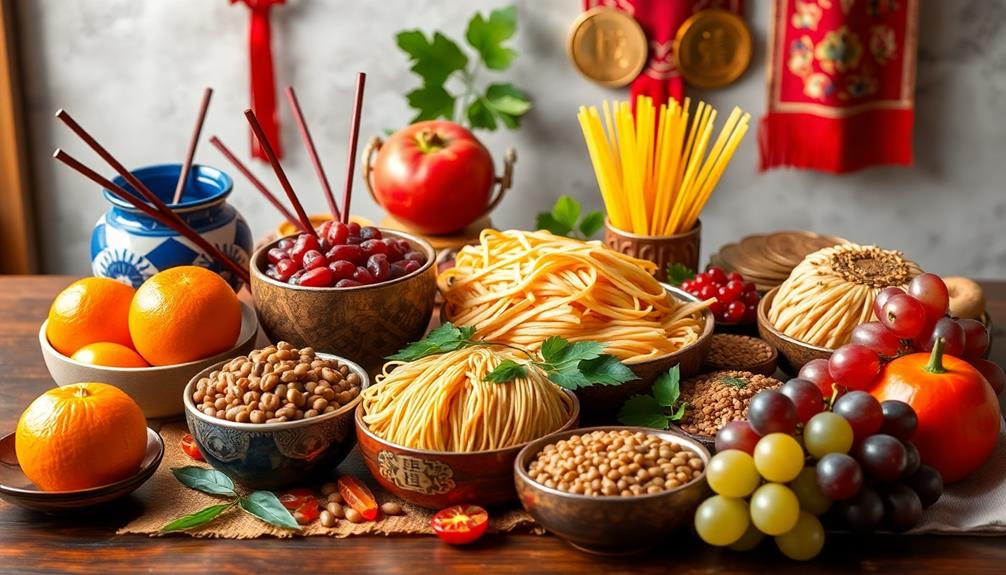
Many cultures celebrate with specific foods believed to bring good luck, and these traditions extend beyond just New Year's festivities. Here's a glimpse at some common lucky foods around the globe:
| Food | Cultural Significance |
|---|---|
| Black-eyed peas | Eaten in the Southern U.S. on New Year's Day, symbolizing luck and financial prosperity. |
| Twelve grapes | Consumed in Spain at midnight on New Year's Eve, with each grape representing a month of the year. |
| Lentils | Enjoyed in Italy during New Year celebrations, as their coin-like shape symbolizes wealth and prosperity. |
| Soba noodles | Eaten in Japan on New Year's Eve, signifying longevity and good fortune through unbroken strands. |
In addition to these, oranges in Chinese culture represent wealth and prosperity, with nine displayed during the New Year to attract good luck. Each of these foods carries a unique significance, reflecting the values and beliefs of their respective cultures. Whether you're celebrating New Year's or just seeking a bit of luck, these foods can be a delicious way to invite prosperity and longevity into your life.
Symbolism of Specific Ingredients
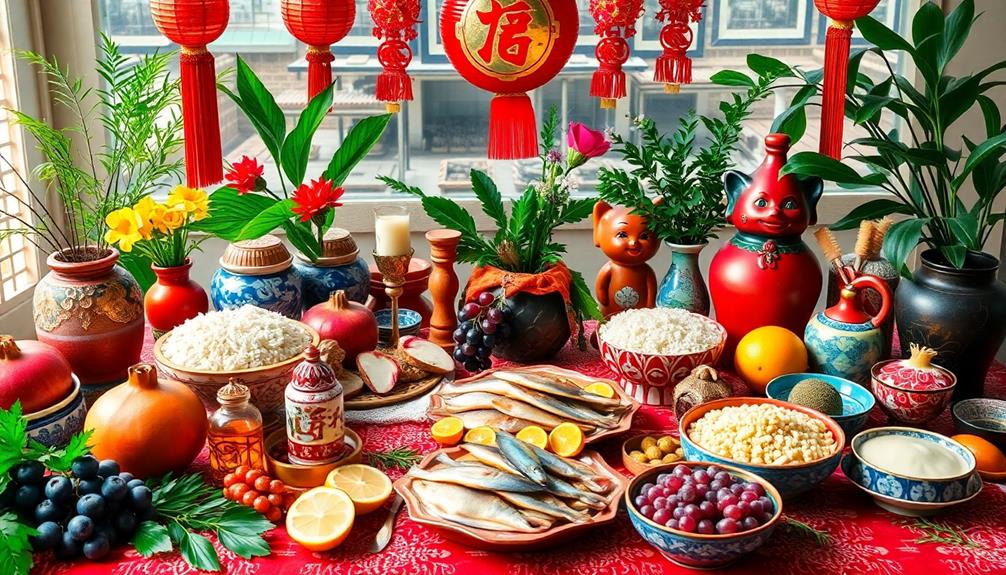
Food isn't just about taste; it often carries deep meanings and symbolism in different cultures. You might find that certain lucky foods are rich in significance, especially during festive occasions like New Year celebrations.
For instance, legumes such as black-eyed peas and lentils symbolize wealth and prosperity. Their round shape resembles coins, making them a staple for good luck in places like the Southern U.S. and Italy. In Japan, traditional treats like Dorayaki (Red Bean Pancake) also carry meaning, often enjoyed during celebrations and symbolizing sweetness in life.
Round fruits, like grapes and pomegranates, represent abundance and fertility. In Spain, it's traditional to consume twelve grapes at midnight, with each grape symbolizing good luck for the months ahead.
Long noodles in Asian cultures embody longevity and resilience; slurping unbroken noodles during New Year's celebrations is believed to bring good fortune.
Pork is another food you might encounter, symbolizing progress and prosperity due to the animal's rooting behavior, which represents forward movement.
Family Traditions and Celebrations

Celebrating with loved ones often involves sharing lucky foods that carry special meanings in various cultures. These traditions not only enhance your family gatherings but also connect you to your cultural heritage.
Here's a glimpse of some popular lucky foods and their significance during celebrations:
| Food | Culture | Meaning |
|---|---|---|
| Black-eyed peas | Southern U.S. | Wealth and prosperity on New Year |
| Twelve grapes | Spain | Luck for each month of the year |
| Lentils | Italy | Financial prosperity |
| Tamales | Mexico | Family bonding and prosperity |
| Collard greens | Southern U.S. | Wealth alongside black-eyed peas |
In the Southern U.S., black-eyed peas and collard greens are staples for New Year's Day, symbolizing wealth. In Spain, you gather with family to eat twelve grapes at midnight for a year filled with fortune. Meanwhile, making tamales during Christmas in Mexico reinforces family bonds. In Italy, lentils with sausage attract financial success. These lucky foods play an essential role in family traditions, fostering togetherness and reinforcing a sense of community.
Frequently Asked Questions
What Foods Are Associated With Luck?
When you think about lucky foods, consider black-eyed peas for prosperity, grapes for good fortune, lentils for wealth, long noodles for longevity, and pomegranates for abundance. Each offers a unique promise for the new year.
Why Do Certain Cultures Eat Certain Foods?
Different cultures eat specific foods due to traditions, beliefs, and local resources. These practices often symbolize hopes for health, prosperity, and good fortune, shaping communal identities and reinforcing cultural significance through shared meals and rituals.
What Are the 7 Lucky New Year's Food Traditions?
You'll find seven lucky New Year's food traditions: eating twelve grapes in Spain, lentils in Italy, black-eyed peas in the Southern U.S., soba noodles in Japan, olie bollen in the Netherlands, and more!
What Food Brings Wealth?
If you're seeking foods that bring wealth, consider black-eyed peas, lentils, and pork. Each symbolizes prosperity in various cultures, promising financial growth and abundance as you enjoy their traditional significance during New Year celebrations.
Conclusion
As you explore the world of lucky foods, remember their rich cultural significance and the joy they bring to celebrations. Did you know that over 1.5 billion people celebrate the Lunar New Year, often gathering around tables filled with symbolic dishes? These traditions not only honor heritage but also create bonds among families and friends. So, the next time you enjoy a meal steeped in meaning, you're part of a global tapestry that values hope and prosperity.
